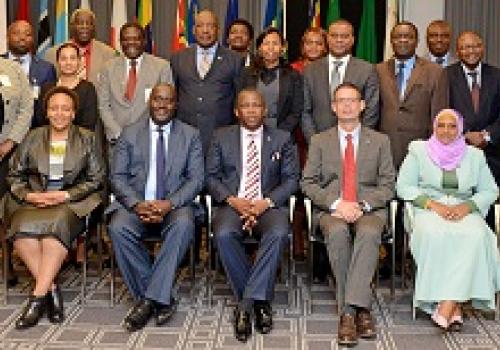The Southern African Development Community (SADC) in collaboration with the European Union (EU) has formally launched the national implementation of projects valued at 31.6 million Euros under the Trade Related Facility (TRF), established through a Contribution Agreement between the EU and SADC in July, 2014.
The launch took place at Protea Fire and Ice Hotel in Pretoria, Republic of South Africa during the meeting of SADC Ministers responsible for Trade on the 14th August 2017.
In his remarks, Hon. Jabulani C Mabuza, Minister of Commerce, Industry and Trade of the Kingdom of Swaziland, thanked the EU for the tireless support rendered to SADC Member States in the promotion of regional integration and in improving the lives of the SADC citizenry.
Director of Policy Planning and Resource Mobilization at the SADC Secretariat, Mr Mubita Luwabelwa thanked the EU for the continued support that SADC gets from the EU in the implementation of regional integration programmes.
Mr Luwabelwa expressed SADC's commitment to the implementation of the Trade Related Facility projects in the Member States in order to make the TRF a critical instrument to further economic integration across the region.
The EU representative, Mr John Taylor who represented the Head of EU Delegation in Botswana and SADC, Ambassador Alexandra Baum, reiterated EU financial commitment to supporting projects which promote regional integration.
Mr Taylor thanked the twelve SADC Member States benefiting from the TRF funding for their unwavering cooperation and collaboration.
The SADC Member States that have signed and ratified the SADC Protocol on Trade and are benefitting from the TRF are; Botswana, Lesotho, Madagascar, Malawi, Mauritius, Mozambique, Namibia, Seychelles, Swaziland, Tanzania, Zambia and Zimbabwe.
The objective of the TRF is to improve the participation of SADC Member States in regional and international trade in order to contribute to sustainable development within the SADC region.
Projects being supported by the TRF mainly focus on customs cooperation, technical barriers to trade (TBT), sanitary and phytosanitary (SPS) measures, rules of origin, trade facilitation, industrial development, trade promotion and development, and trade in services. In addition, there are specific areas that relate to the EPA Window, namely trade defence instruments, trade related adjustment and competition policy.

